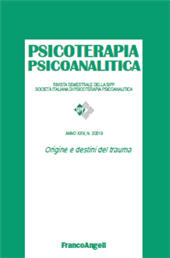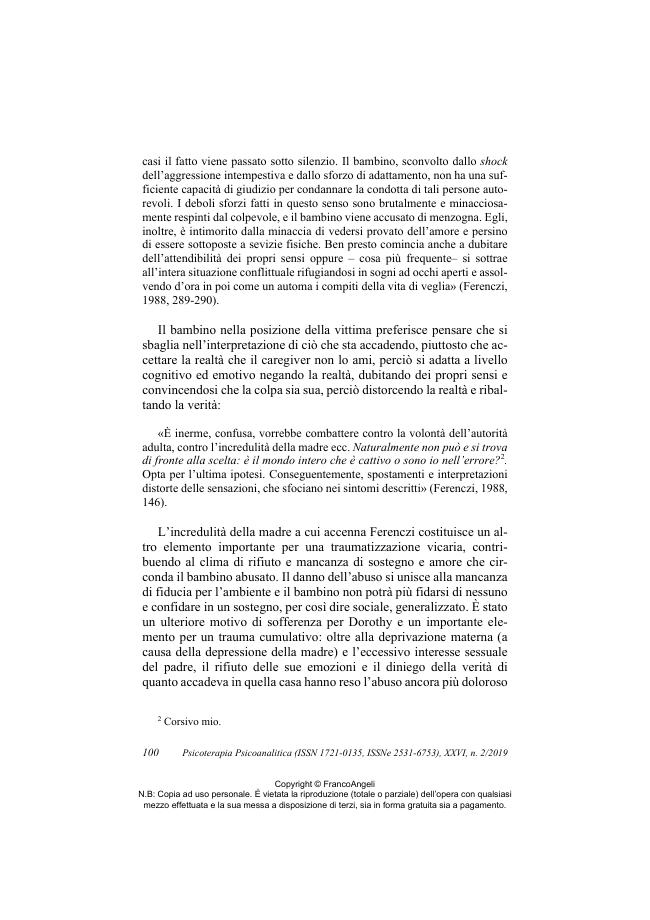2019 - Franco Angeli
Article
Digital Version
Download | Copy/paste | Printing
Trauma e attaccamento nei pazienti borderline
91-108 p.
- Integrando psicoanalisi relazionale (in particolare Ferenczi) e oggettuale (Green, Kernberg) con le neuroscienze affettive (Schore, Panksepp) e le teorie dell'attaccamento e della dissociazione (Schore, Liotti) l'autrice pone le basi per una eziopatogenesi traumatica del disturbo di personalità e conseguentemente per una clinica del trauma basata sulla regolazione affettiva nel campo terapeutico. Le conseguenze neurobio-logiche e le dinamiche affettive di tre essenziali livelli di trauma da mano umana relazionale (infantile, o dell'attaccamento, maltrattamento e abuso, trauma massivo) sono descritti e distinti dalle traumatizzazioni dovute a catastrofi naturali o accidentali, in particolare le conseguenze del Complex PTSD (da maltrattamento e abuso prolungati in una relazione), ancora non riconosciuto nel DSM ma riconosciuto nel PDM-2.
- Viene illustrato brevemente un caso di una paziente borderline per indicare alcuni procedimenti fondamentali con il paziente da trauma relazionale e da Complex PTSD (primo e secondo livello), per esempio l'internalizazzione della diade vittima-persecutore tipica dei traumi complessi. La clinica che viene presentata si basa su un processo che l'autrice chiama "testimonianza incarnata", incentrata su una integrazione dei vari circuiti mente-corpo-cervello, attraverso mirroring, enactment e regolazione affettiva costante nei margini della finestra di disregolazione affettiva nella comunicazione intersoggettiva tra i due soggetti della clinica. [Testo dell'editore].
- The author proposes an integration of some dynamics of relational psicoanalysis (with special reference to Ferenczi) and object relation theory (Green, Kernberg) with affective neuroscience (Schore, Panksepp) and attachment theory and dissociation (Schore, Liotti) in order to indicate and discuss clinically the effects of three levels of trauma of human agency as the eziopathological factor oat the basis of the functioning of severe personality disorders. The neurobiological consequences and the affective and psychological dynamics of three levels of trauma of human agency (early relational trauma, maltreatment and abuse, and massive social traumatizations) are described and cast in contrast with traumatizations of natural catastrophies or accidents which do not create dissociation (because they do not involve an affective realtion) and are not at the basis of what is called Complex PTSD.
- (traumatization stemming from long term abuse in a relation-ship), still unrecognised by DSM-5 and acknowledged only by PDM-2. A brief description of a borderline patient follows, with a clear internalization of the victim-persecutor dyad of traumatic origin, with the indication of the particular affective repartion and the steps to follow to restablish affect regulation in the therapy, a process the author calls "embodied witnessing", based on the usage of the various circuits of the mind-body-brain, through appropriate mirroring of the split parts, through enactments and constant affect regulation, at the borders of the window of affect dysregulation between the two subjects of the therapeutic process. [Publisher's text].
Is part of
Psicoterapia psicoanalitica : 2, 2019-
Information
ISSN: 2531-6753
KEYWORDS
- Trauma, affect regulation, victim-persecutor dyad, per-sonality disorders, borderline
- Trauma, affect regulation, victim-persecutor dyad, personali-ty disorders, borderline
-
In this issue
- Editoriale
- Il trauma dell'analista
- Trauma precoce e principio di speranza : il ruolo dell'allucinatorio
- Trauma emotivo e sviluppo psicopatologico
- Trauma e attaccamento nei pazienti borderline
- Diagnosi di emofilia : il trauma non rappresentabile
- Usi e abusi del trauma nell'Arte Irregolare
- Il vissuto del trauma nell'équipe istituzionale
- Frammenti
- Trauma e reazione terapeutica negativa
- La consultazione nel trauma della violenza di genere
- Una nuova casa psichica : traumaticità e ricostruzioni terapeutiche : il caso di Dolcino
- Recensioni
- In ricordo di Wivie Benaim



